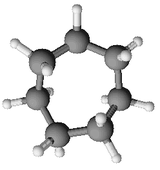Cycloheptane
- Cycloheptane
-
| Cycloheptane |

 |
| Général |
| No CAS |
291-64-5 |
| No EINECS |
206-030-2 |
| SMILES |
|
| InChI |
InChI : Vue 3D
InChI= 1/ C7H14/ c1- 2- 4- 6- 7- 5- 3- 1/ h1- 7H2
|
| Propriétés chimiques |
| Formule brute |
C7H14 [Isomères]
|
| Masse molaire[2] |
98,1861 ± 0,0066 g·mol-1
C 85,63 %, H 14,37 %,
|
| Susceptibilité magnétique |
χM 78,9 ± 0,7×10-6 cm3·mol-1[1] |
| Propriétés physiques |
| T° fusion |
-12 °C |
| T° ébullition |
118,1 °C [3] |
| Masse volumique |
0.8110 |
| Point d’éclair |
6 °C |
| Point critique |
331,05 °C [3], 38,1 bar [4] |
| Thermochimie |
| Cp |
équation[5] : 
Capacité thermique du gaz en J·mol-1·K-1 et température en kelvins, de 100 à 1 500 K.
Valeurs calculées :
135,152 J·mol-1·K-1 à 25 °C.
T
(K) |
T
(°C) |
Cp
 |
Cp
 |
| 100 |
-173,15 |
47 956 |
488 |
| 193 |
-80,15 |
87 906 |
895 |
| 240 |
-33,15 |
108 904 |
1 109 |
| 286 |
12,85 |
129 662 |
1 321 |
| 333 |
59,85 |
150 863 |
1 537 |
| 380 |
106,85 |
171 853 |
1 750 |
| 426 |
152,85 |
192 012 |
1 956 |
| 473 |
199,85 |
212 056 |
2 160 |
| 520 |
246,85 |
231 396 |
2 357 |
| 566 |
292,85 |
249 521 |
2 541 |
| 613 |
339,85 |
267 115 |
2 720 |
| 660 |
386,85 |
283 689 |
2 889 |
| 706 |
432,85 |
298 858 |
3 044 |
| 753 |
479,85 |
313 235 |
3 190 |
| 800 |
526,85 |
326 451 |
3 325 |
|
T
(K) |
T
(°C) |
Cp
 |
Cp
 |
| 846 |
572,85 |
338 255 |
3 445 |
| 893 |
619,85 |
349 172 |
3 556 |
| 940 |
666,85 |
358 965 |
3 656 |
| 986 |
712,85 |
367 511 |
3 743 |
| 1 033 |
759,85 |
375 250 |
3 822 |
| 1 080 |
806,85 |
382 077 |
3 891 |
| 1 126 |
852,85 |
387 983 |
3 952 |
| 1 173 |
899,85 |
393 351 |
4 006 |
| 1 220 |
946,85 |
398 196 |
4 056 |
| 1 266 |
992,85 |
402 595 |
4 100 |
| 1 313 |
1 039,85 |
406 924 |
4 144 |
| 1 360 |
1 086,85 |
411 294 |
4 189 |
| 1 406 |
1 132,85 |
415 832 |
4 235 |
| 1 453 |
1 179,85 |
420 979 |
4 288 |
| 1 500 |
1 226,85 |
426 908 |
4 348 |
|
|
| Précautions |
|
Directive 67/548/EEC
|
|
|
Symboles :
Xn : Nocif
F : Facilement inflammable
N : Dangereux pour l’environnement
Phrases R :
R11 : Facilement inflammable.
R65 : Nocif : peut provoquer une atteinte des poumons en cas d’ ingestion.
Phrases S :
S16 : Conserver à l’ écart de toute flamme ou source d’ étincelles - Ne pas fumer.
S23 : Ne pas respirer les gaz/ fumées/ vapeurs/ aérosols [ terme( s) approprié( s) à indiquer par le fabricant].
S62 : En cas d’ ingestion, ne pas faire vomir. Consulter immédiatement un médecin et lui montrer l’ emballage ou l’ étiquette.
S24/25 : Éviter le contact avec la peau et les yeux.
|
| Phrases R : 11, 65, |
| Phrases S : 16, 23, 24/25, 62, |
|
Transport
|
Numéro ONU :
2241 : CYCLOHEPTANE
|
|
NFPA 704
|
|
|
|
Unités du SI & CNTP, sauf indication contraire.
|
Le cycloheptane est un alcane cyclique à sept atomes de carbone. Il a pour formule brute C7H14
Notes et références
- ↑ (en) Hyp J. Dauben, Jr., James D. Wilson et John L. Laity, « Diamagnetic Susceptibility Exaltation in Hydrocarbons », dans Journal of the American Chemical Society, vol. 91, no 8, 9 avril 1968, p. 1991-1998
- ↑ Masse molaire calculée d’après Atomic weights of the elements 2007 sur www.chem.qmul.ac.uk.
- ↑ a et b (en) Iwona Owczarek et Krystyna Blazej, « Recommended Critical Temperatures. Part II. Aromatic and Cyclic Hydrocarbons », dans J. Phys. Chem. Ref. Data, vol. 33, no 2, 30 avril 2004, p. 541 [lien DOI]
- ↑ Properties of Various Gases sur flexwareinc.com. Consulté le 12 avril 2010
- ↑ (en) Carl L. Yaws, Handbook of Thermodynamic Diagrams, vol. 2, Huston, Texas, Gulf Pub. Co. (ISBN 0-88415-858-6)
Catégories : - Produit chimique nocif
- Produit chimique facilement inflammable
- Produit chimique dangereux pour l'environnement
- Cycloheptane
Wikimedia Foundation.
2010.
Contenu soumis à la licence CC-BY-SA. Source : Article Cycloheptane de Wikipédia en français (auteurs)
Regardez d'autres dictionnaires:
Cycloheptane — Cycloheptane … Wikipedia
cycloheptane — ● cycloheptane nom masculin Cycloalcane C7H14 … Encyclopédie Universelle
cycloheptane — noun An alicyclic hydrocarbon, CH; a volatile inflammable liquid. See Also: heptane … Wiktionary
cycloheptane — cy·clo·heptane … English syllables
cycloheptane — | ̷ ̷ ̷ ̷ at cyclo + noun Etymology: International Scientific Vocabulary cycl + heptane : an oily saturated cyclic hydrocarbon C7H14 … Useful english dictionary
291-64-5 — Cycloheptane Cycloheptane Général No CAS … Wikipédia en Français
Cycloalkane — Ball and stick model of cyclobutane Cycloalkanes (also called naphthenes not to be confused with naphthalene) are types of alkanes that have one or more rings of carbon atoms in the chemical structure of their molecules. Alkanes are types of… … Wikipedia
Cyclohexane — Cyclohexane … Wikipedia
Cyclooctane — Identifiers CAS number … Wikipedia
Cycloheptan — Strukturformel Allgemeines Name Cycloheptan Andere Namen … Deutsch Wikipedia









